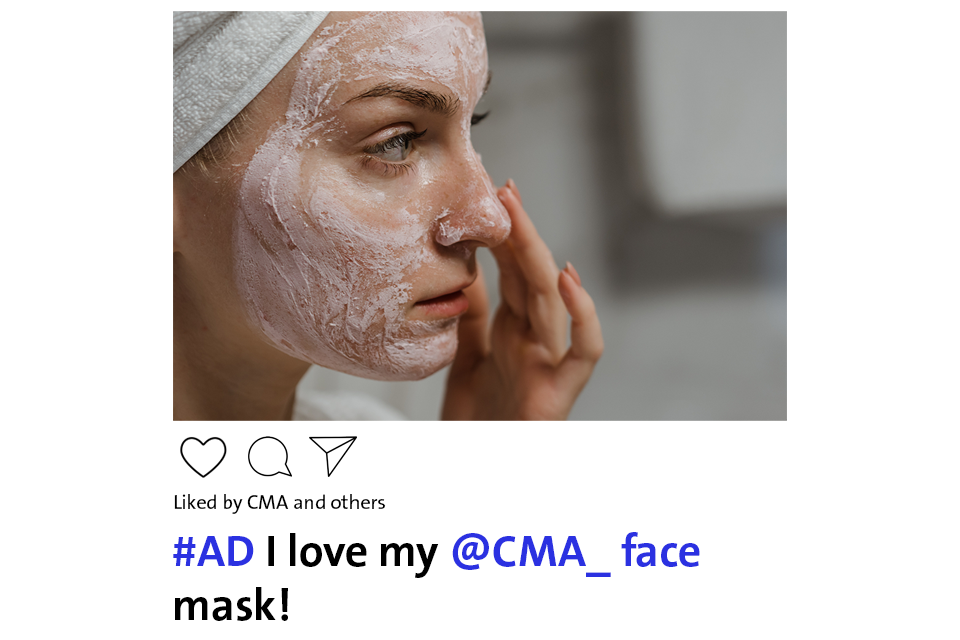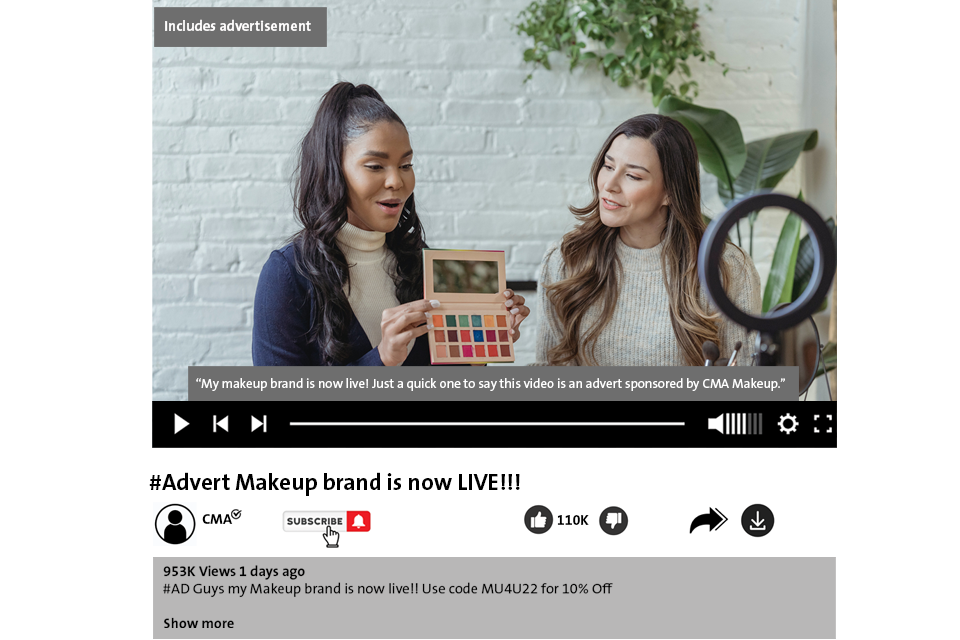Social media endorsements: guidance for content creators
Updated 3 September 2025
Online content creators, such as bloggers, influencers, online streamers, celebrities and social media personalities, can have a big impact on a customer’s buying behaviour.
If you use hidden ads or otherwise engage in misleading practices, you may be in breach of consumer protection law and face a substantial fine. It may also mean you could be breaking industry rules on advertising, which are enforced by the . Non-compliant content creators can be for not abiding by advertising rules.
If you’ve been incentivised in any way to promote a brand or product in your social media content, it’s important that all this content is clearly identifiable as an ad (or advertising), and reflects your genuine experience.
“Product” covers goods, services and digital content.
This rule applies to any content including:
- photos (including carousels)
- �������Dz���
- ����������
- ���ٴǰ��������
- ��ǻ峦�����ٲ���
- other posts online
This includes where you’ve been paid to post content, received a gift, or posted content about your own business.
If you’re creating content for an online audience, whenever you’ve been incentivised to post, it must be clearly labelled as an advert or ad, and be based on your genuine experience.
This includes:
- �������
- ��Ի�ǰ�����Գٲ���
- commercial relationships, including sponsorships
- competitions, prize draws or giveaways
- affiliated links or programmes
- discount codes
- business partnerships
- own brand promotions
- product placement
- ���𱹾���ɲ���
- content about gifts received for ‘free’
Working with others
This guidance applies to both formal agreements, such as written contracts or other agreements, and to more informal arrangements, including verbal or other situations where you’ve been incentivised to promote, endorse or review a product.
It also includes businesses sending products or invites to events without asking for anything in return (‘freebies’ or ‘gifts’). It also applies where you post content about your own business too.
Everyone involved in creating content like this on social media must take responsibility to ensure all ads are labelled correctly.
Any form of incentive or reward – including money, commissions, discounts, leases or loans free of charge or in more favourable terms than those offered to the general public, gifts of any products – is payment.
This guidance applies to you if you’ve received a product for free or at a discounted rate (or received other incentives, such as direct payment or commission) in connection with your social media accounts, no matter how many followers you have.
Avoid misleading your audience
Hidden ads are illegal and harmful as they can persuade people to buy things they might not usually buy if they’d known that the content was not a non-biased opinion, review or recommendation.
Posting about products or brands without labelling them as an ad can mislead your audience if you give the impression that you:
-
are a consumer when in fact you’re acting for your own businesses’ purposes, or on behalf of a brand (Brand Ambassador)
-
have bought something, when this was given to you as a gift or on a loan
-
have used the product yourself when you haven’t
-
have claimed something in the content that you don’t know is true
It’s a problem, and illegal, if you give the impression that any results you’ve claimed on social media are ones you’ve achieved or experienced first-hand when you’ve in fact been paid in some way to say it.
The content must also not make false or unsupported statements. For example, do not say that something tastes good, washes well, etc if you have not tried it.
Don’t claim something is eco-friendly if you can’t prove it. If you are trying to demonstrate the benefits of a beauty product don’t exaggerate the results through a video or photo filter on the platform.
Labelling ads
All commercial content must be correctly labelled and clearly identifiable as an ad. This also includes where you post about any gifts you’ve received, even if there’s no obligation for you to do anything with it.
To do this, all labels must be clear, prominent and easy to understand. It is not enough just to tag a brand in your post, use discount codes or affiliate links.
Easy to understand and easily defined (transparent and unambiguous)
You should use a label that clearly identifies your content as an ad, or advert, such as:
- ad
- ���屹�������
- ‘A��’
- ���屹����پ������Բ���
- advertisement

The above image is an example of a post, which in the CMA’s view, would likely comply with the requirements of consumer protection law.
Some platforms have tools to label content automatically, like ‘paid partnership’ or ‘branded content’. You can also use these provided the label is clear and easy to see or access.
You should consider whether the labelling tool clearly conveys that the content is an ad; if not, you should include the label #Ad in a clear, upfront position.
Words to avoid
You should avoid unclear or ambiguous terms such as:
- ‘#�����ڳ�’
- ‘#�����ڳٱ��’
- ‘#���ڴ�’
- ‘#���ڴھ��������ٱ�’
- ‘#���DZ�������’
- ‘#�ʸ�հ�����’
- ‘#����Dz�’
- ‘#����DzԲ��ǰ����’
- ‘Funded by’
- ‘In association with’
- ‘made possible by’
- ‘my products’
- ����������Ի�’
- ‘o�ɲԲ������Ի�’
- ‘PR Haul’
- ‘PR Stay’
- ‘thank you’
- or just naming the brand
Clearly shown in posts (prominent)
Your audience should be able to understand that your content is an ad, as soon as they access or engage with it, regardless of the format or media used.
Disclosure labels should not be hidden or buried in many other hashtags or poorly contrasted with the content background.
It must be immediately clear that your content is an ad. Your audience should not have to:
- scroll or select the link for more information
- re-size the screen on a device to access the content
- study the content carefully to see the disclosure
- access your profile page or bio
- already be aware of previous content you’ve posted
If they do, you will need to adjust or edit your content to ensure your audience can recognise it’s an ad.
Ad is obvious from the first interaction (timely)
All promotional content should be labelled as advertising, and this must be obvious as soon as anyone engages with the content.
This includes content such as podcasts or videos, where the disclosure for ads must be given at the beginning of the ad.
If you use carousels (video or photos), or sequences where your audience can access individual posts: you must also label each item that contains promotional messaging.
Working with multiple brands
You should be clear which brands you’re advertising for in your post.
Your own brand or products
If you own (in full, co-own or in part), or are employed by or otherwise connected with a brand and use your social media account to promote it or its products, you must make this known and clearly label these posts as ads. If you are promoting any brand that you, your family, or your friends own, it needs to disclosed as advertising.
To see examples, visit Advertising Standard Authority (ASA)’s rulings for ,�� and .
You should not rely on your bio, previous posts or selecting links for more information for your followers to discover what relationship you have with the brand you’re promoting or advertising. This should be clear from the face of the content.

The above image is an example of a video endorsement, which in the CMA’s view, would likely comply with the requirements of consumer protection law.
More information
You could face enforcement action from the CMA, local authority Trading Standards Services, or the Department for the Economy in Northern Ireland if your content misleads consumers.
For more guidance, see:
-
CMA guidance collection on online reviews and endorsements and the CMA’s case finder, for detail on previous and ongoing casework
-
The Committee of Advertising Practice (CAP) and CMA explains how to comply with consumer protection law and the Advertising Codes enforced by the ASA. You can also visit on this topic.
-
ASA research on
These materials do not constitute legal advice and should not be relied upon as such.

